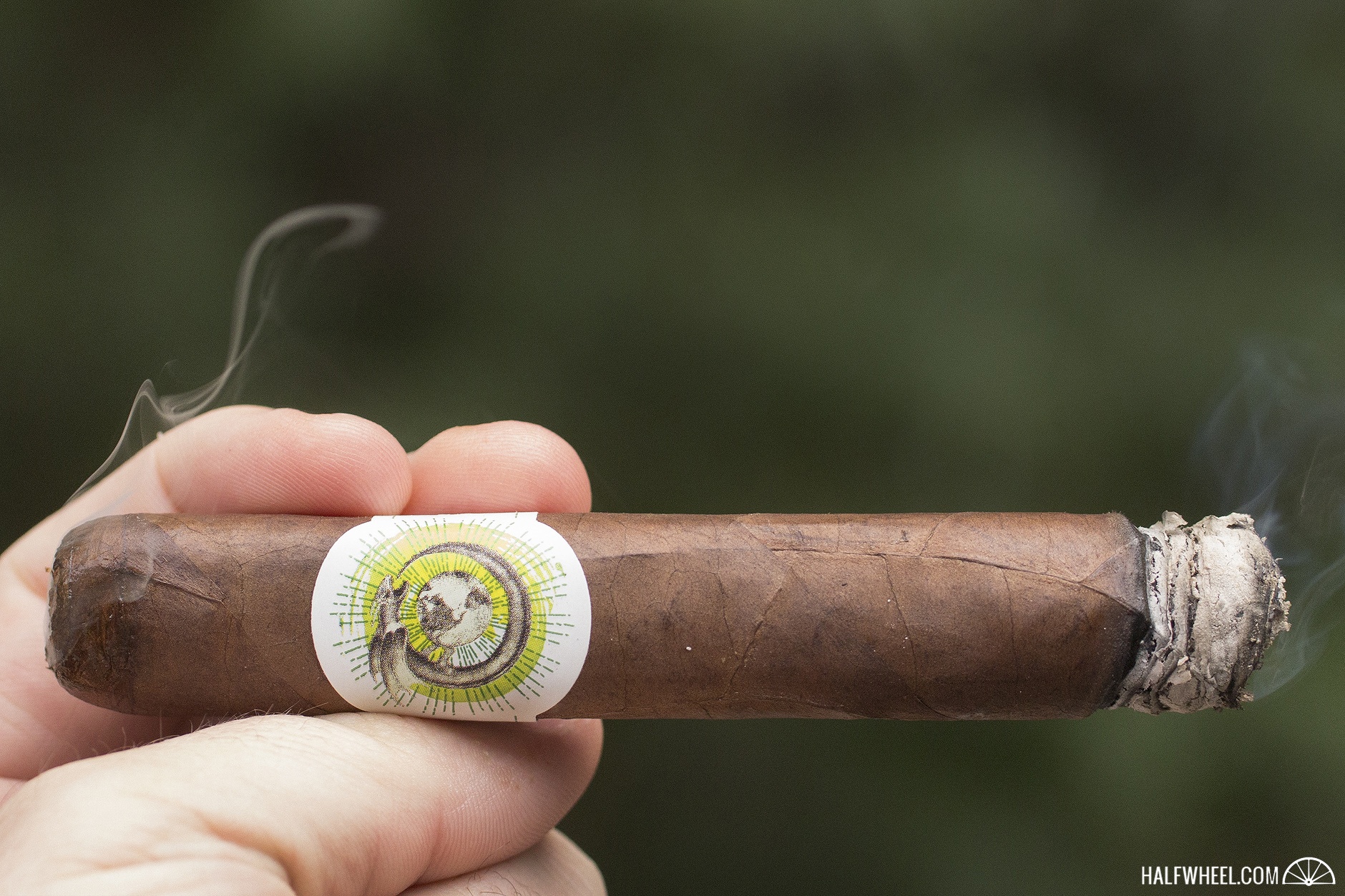Ventura Cigar Co., the premium cigar arm of Phillips & King International, has largely been known for two lines in recent years, PSyKo SEVEN and Project 805, which they released at the 2013 IPCPR Convention & Trade Show. The pair became the new headliners of the company’s portfolio after the Pura Sangre line that had previously been the showcase cigar was phased out at the end of 2014.
While those two lines remain, Ventura Cigar Co. used the 2016 IPCPR Convention & Trade Show to launch an entirely new set of cigars, a total of 66 SKUs to be exact. The headlining line of those new releases is Archetype, which is a collection of five cigars inspired by Dr. Carl Jung and Joseph Campbell, the former of whom wrote about the concept of archetypes and the latter applying them to a hero’s journey, which is often found in storytelling.
“The Archetype brand is inspired by the work of psychologist Dr. Carl Jung and the writings of mythographer Joseph Campbell who defined ‘archetypes’ as the constantly repeating characters who occur in the dreams of all people and the myths of all cultures,” said Jason Carignan, the company’s chief marketing officer, in a press release.
“Campbell discovered through his study of world myths that the ‘Hero’s Journey’ is a common storytelling arc that has been retold in infinite variations since time began. Cigar smoking is really no different; we gather and we weave our tales as we share a couple of sticks and a glass of fine whiskey.”
The line is split into two groups, Series A, which is being produced at Oettinger Davidoff AG’s Occidental Cigar Factory in the Dominican Republic and Agroindustria LAEPE S.A. factory in Honduras, and Series B, which comes from Drew Estate’s La Gran Fabrica Drew Estate in Estelí, Nicaragua.
Series A is made up of Dreamstate, Sage Advice and Strange Passage, with the first two produced in the D.R. and the third in Honduras. Series B offers two cigars, Initiation and Axis Mundi, and is only available to Ventura’s VSR accounts.
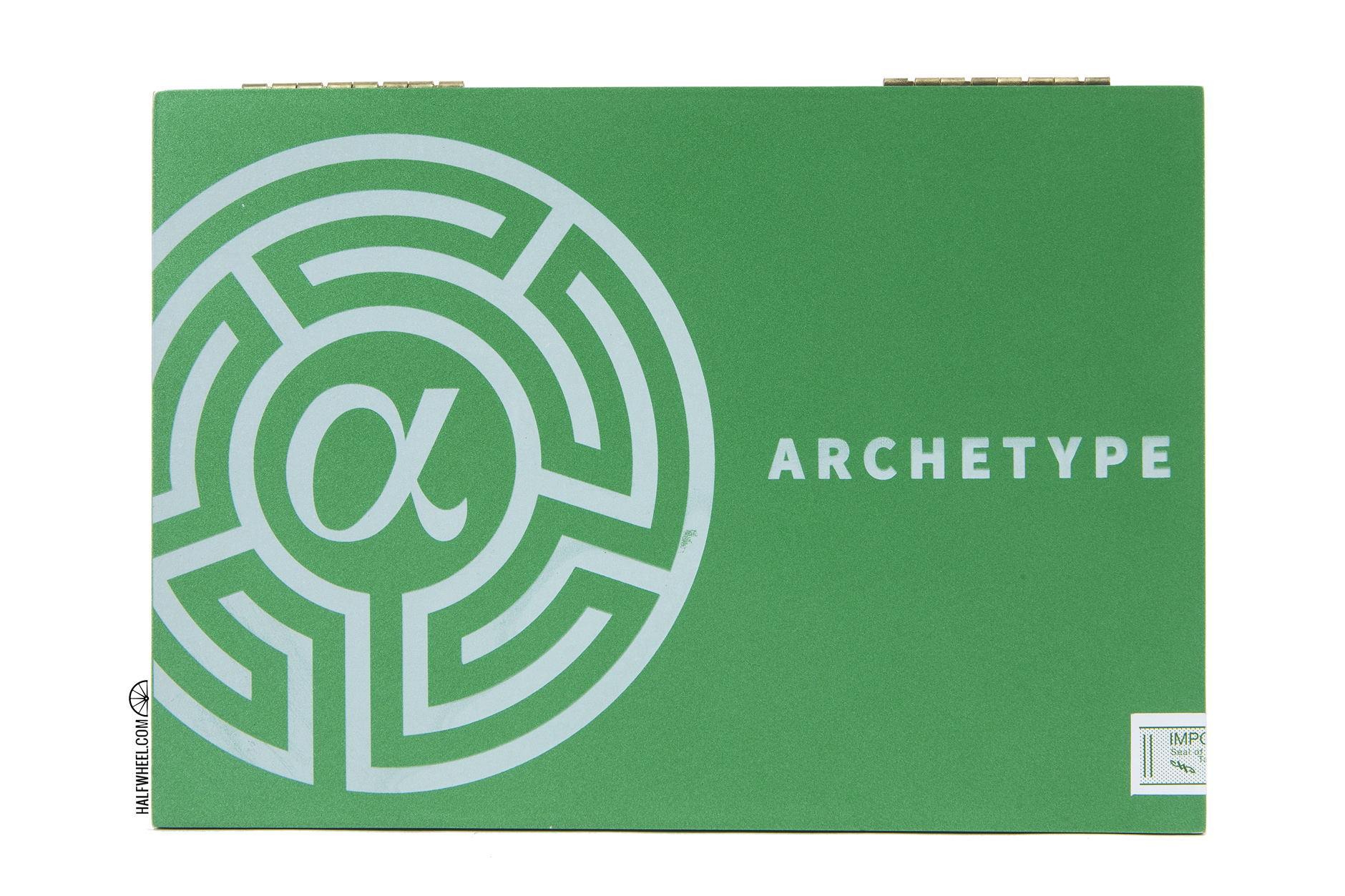
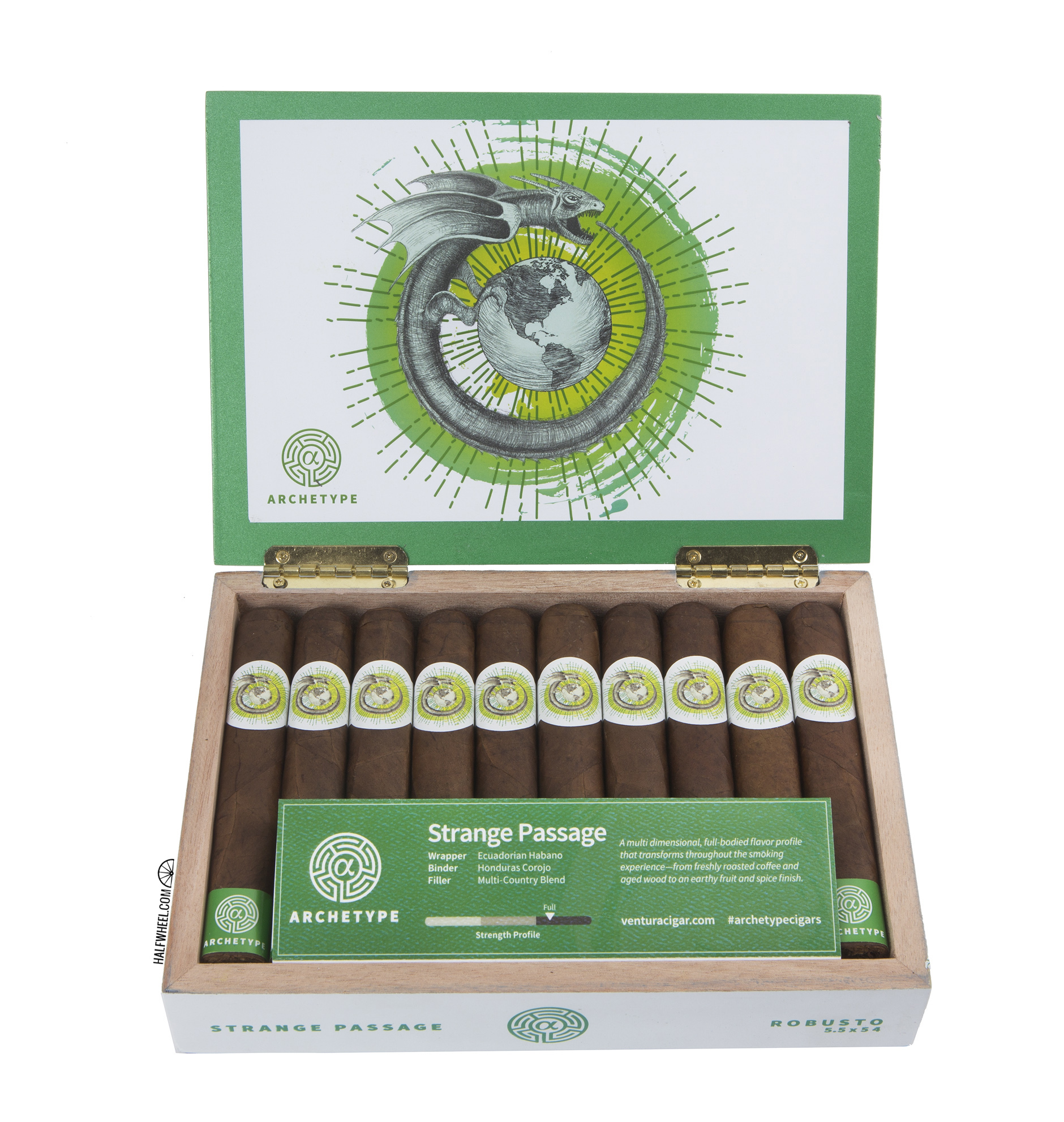
The Archetype Strange Passage line features a blend of an Ecuadorian habano wrapper, Honduran corojo binder and an undisclosed, multi-country blend of filler tobaccos.
It comes in three box-pressed sizes: Short Robusto (4 1/4 x 50, $8.99), Robusto (5 1/2 x 54, $10.49) and Toro (6 x 60, $12.49), and as previously mentioned, is made in Honduras at Agroindustria LAEPE S.A. The company says that it is “a multi-dimensional, full-bodied flavor profile” with notes of roasted coffee, aged wood, earthy fruit and spice on the finish.
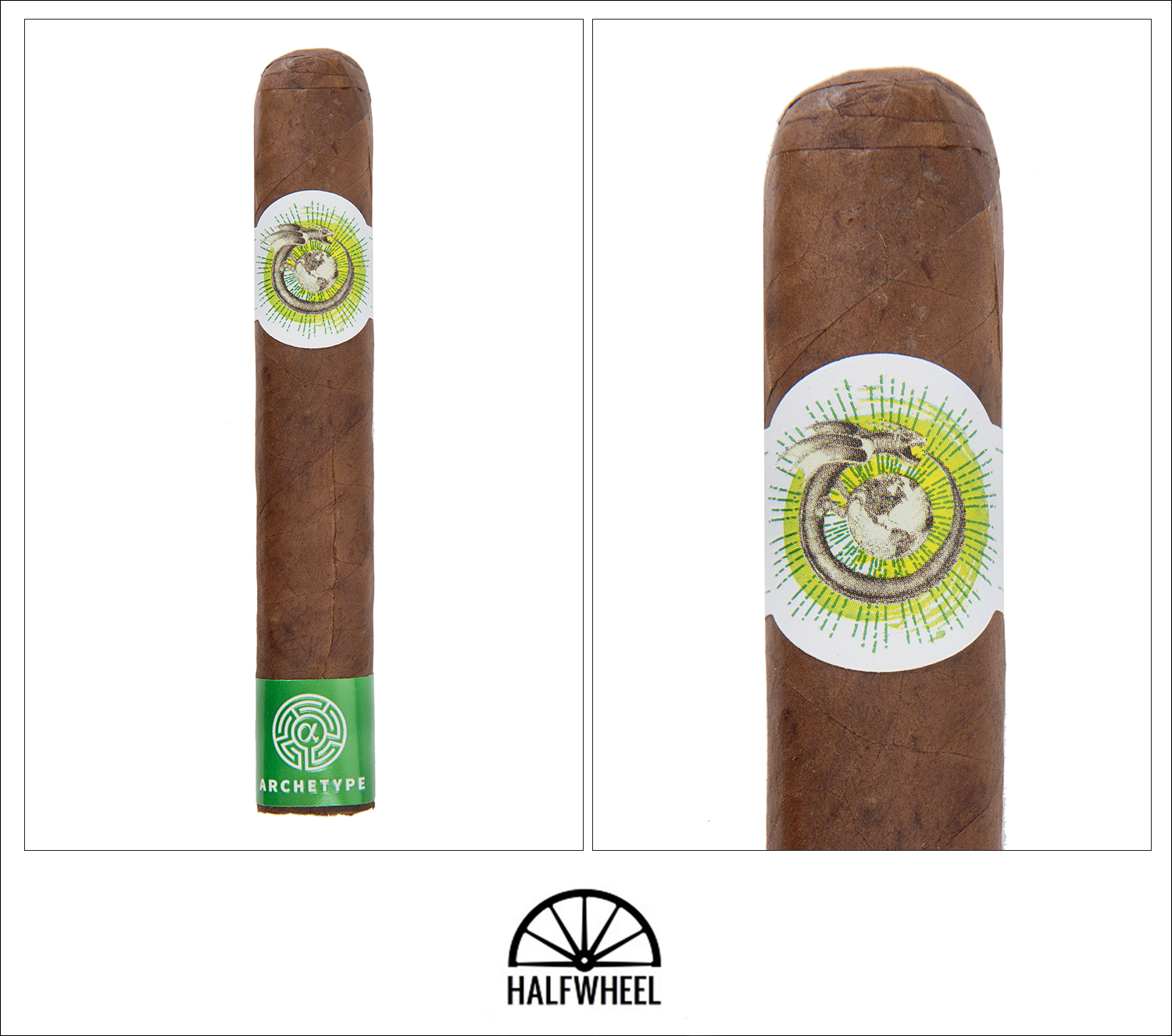
- Cigar Reviewed: Archetype Strange Passage Robusto
- Country of Origin: Honduras
- Factory: Agroindustria LAEPE S.A.
- Wrapper: Ecuadorian Habano
- Binder: Honduran Corojo
- Filler: n/a
- Length: 5 1/2 Inches
- Ring Gauge: 54
- Vitola: Robusto
- MSRP: $10.49 (Boxes of 20, $209.80)
- Release Date: Aug. 1, 2016
- Number of Cigars Released: Regular Production
- Number of Cigars Smoked For Review: 3
Outside of the distinct visual on the front of the band, the Archetype Strange Passage is a fairly standard looking cigar. Given that it is the only box-pressed offering in the Archetype line, it would seem to warrant some additional scrutiny, and the cigar is well made if not pressed firmly; in fact, it rolled down my laptop’s keyboard fairly easily as I was getting ready to start the first sample. It’s also a somewhat soft cigar, showing some typical box-press give in each sample, with one feeling particularly soft. The wrapper itself is a mottled brown that has me thinking of coffee beans with a smooth texture despite a vein structure that makes hiding nearly impossible. The foot offers root beer foam and dry jerk-marinated meat–chicken the most commonly smelled—with a bright and fairly light texture to the combination and just a bit of pepper. The cold draw has a bit of that same sweet tanginess on the slightly loose draw, backed by roasted cashews and again, just a touch of pepper.
The first puffs of the Archetype Strange Passage are hard to pin down; I hate calling something interesting or distinct, but that’s what comes to mind here as I can’t say I’ve tasted such a combination before. There’s a bit of coffee bean, some interesting woodiness, and hints of black pepper through the nose that don’t really come together in any cohesive form. By the time the first inch or so has burned—with a quite uneven burn line in the second sample—there is a distinct harshness that is going after the throat; not overly aggressively, but with the persistence of a nagging child. There is a bit of an ashy taste to finish out the first third, with some pepper highlighting the relatively mild—or at least uninspiring—profile. The cigar has performed decently from a technical perspective, offering anywhere from adequate to ample amounts of smoke despite a somewhat varying draw.

The second third of the Strange Passage puts the harshness on hold for a bit and shifts into a slightly sweet and oaky flavor, almost reminding me of over-oaked California chardonnays of the early 2000s. There’s a bit of butteriness here as well, though the cigar appears destined on establishing its roots in a heavier profile. Retrohales have become piercingly sharp, a disappointment for someone who likes to get as much smoke through the nose as possible. For the most part, this portion of the cigar cruises along without much fanfare, needing a relight as it transitions to the final third while showing a bit of sweet earth, hints of chocolate brownie and a pepper component that is only felt on the exhale and lingering finish.

The final third starts strong, both in terms of flavor and potential, with the former holding well and latter quickly diminishing. What sweetness may have been promised coming out of the second third has largely diminished, and the cigar turns toward bitter espresso and a metallic taste in the front of the mouth. There’s some harshness in this section that hasn’t been experienced prior, and without a significant pepper component to confuse it with, it’s pretty clear that this cigar has its rough spots. A bit of syrupy sweetness returns in an attempt to counteract the irritation a bit but far from makes up for it or masks it. The soft smoke also tries to minimize the damage to the throat, and while enjoyable, again falls short outside of its own merits. A few touch-ups only compound this section’s problems and makes it the most difficult to get through; with the end in sight each puff becomes more of an encouragement to just lay the cigar to rest. Despite the cigar not presenting itself as being terribly nicotine-laden at any point, it now does and there is a less than idyllic physical effect being felt as the burn line struggles to stay even.
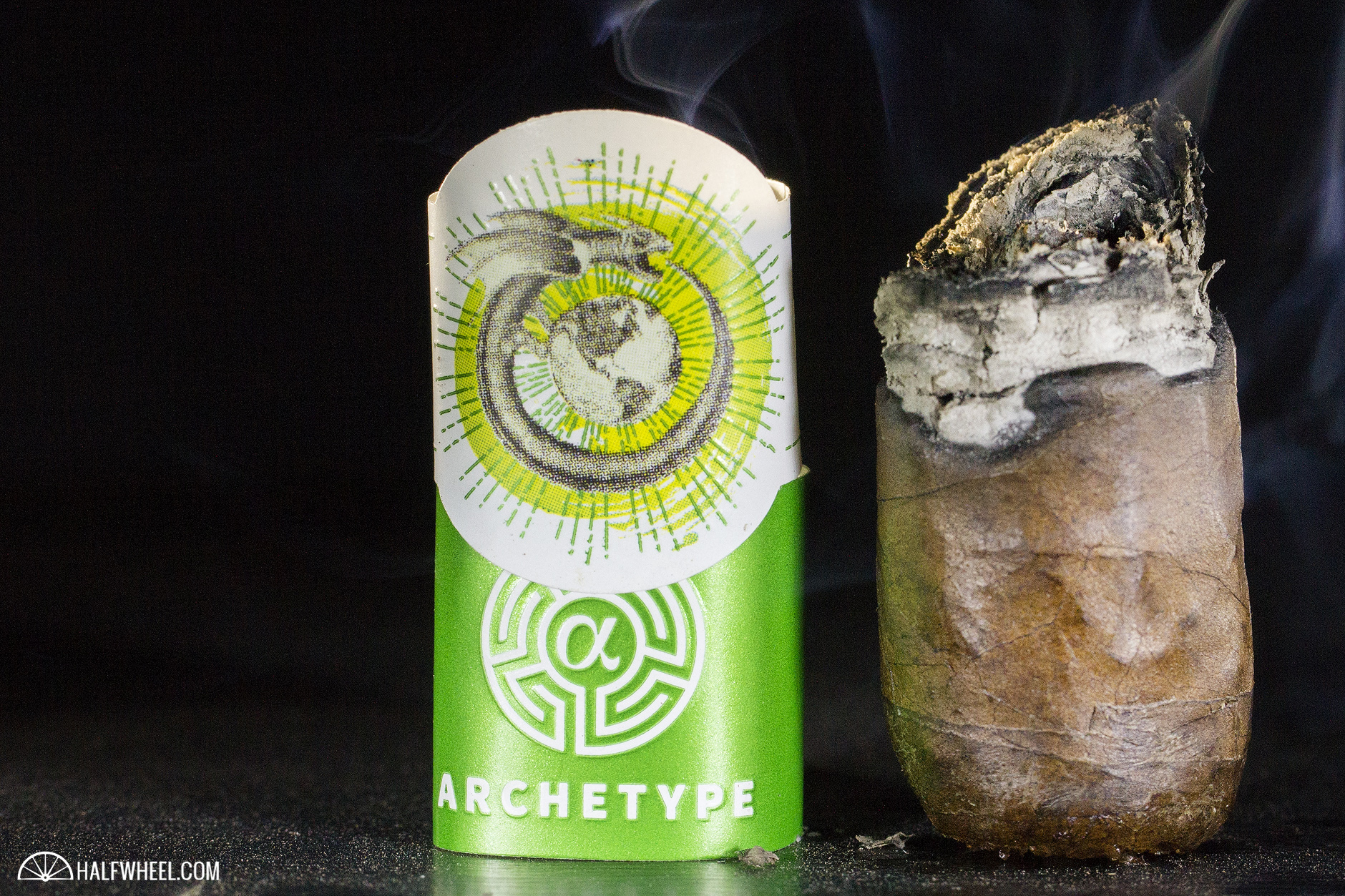
Final Notes
- If non-traditional bands are appealing, the Archetype Strange Passage should certainly be of interest.
- Green is a rarely used color on cigar bands, for the primary reason that it might suggest young tobacco is present in the cigar. Since green spots on tobacco are frowned upon, that disdain has carried over to bands, though as more cigars to market, the color has had to be used out of almost sheer necessity.
- The image on the band is that of The ouroboros—or oroboros—a winged serpent (or dragon) that is eating its own tail. The symbol traces its roots to ancient Egypt and represents self-reflexivity, introspection, or cyclicality, according to its Wikipedia post. Moreover, it conveys a sense of a being constantly re-creating itself, “the eternal return, and other things such as the phoenix which operate in cycles that begin anew as soon as they end. It can also represent the idea of primordial unity related to something existing in or persisting from the beginning with such force or qualities it cannot be extinguished.” It has been used in religious and mythological symbolism as well as in alchemical illustrations, “where it symbolizes the circular nature of the alchemist’s opus.”Wikipedia goes onto say that “Carl Jung interpreted the ouroboros as having an archetypal significance to the human psyche. The Jungian psychologist Erich Neumann writes of it as a representation of the pre-ego ‘dawn state,’ depicting the undifferentiated infancy experience of both mankind and the individual child.”
- I wasn’t quite sure what to make of the burn issues in this cigar; I’m always trying to feel out the blend, oiliness and burn rate during the first sample, but the softness and burn issues in the first third of the second sample forced me to start the dryboxing process for the third sample immediately.
- The third sample got about 12 hours of dryboxing, and it seems to have helped in the first third; it’s impossible to know how it would have smoked had it not gotten some dryboxing of course, but the profile was lighter and a bit drier, while the burn improved a bit as well. It didn’t fix every problem found in the Archetype Strange Passage, particularly in the second and final thirds, but it helped. If I could do it again, I would give all three samples at least two or three days of dryboxing before smoking them.
- If you had told me about the Archetype line—and its imagery and inspiration—but not who was making them, my first guess would have been Foundry Tobacco Co.
- The 5 Vegas brand, which is well known amongst catalog and online-only retailers, features a vitola called the Archetype, a 6 x 50, in its Series ‘A’ line.
- Beyond the factories used for Archetype, Ventura Cigar Co. recruited numerous other ones for the company’s new releases from the trade show, including TAVICUSA, Plasencia Cigars S.A. and La Aurora.
- In March 2014, I reviewed the Pura Sangre Edición 2012 from Ventura Cigar Co. and found it to be quite enjoyable.
- Philips & King International is the largest tobacco products distributor in the U.S. is a subsidiary of Kretek International.
- The cigars for this review were provided by Ventura Cigar Co., which advertises on halfwheel. Oettinger Davidoff AG, which produces the cigars for Ventura, also advertises on halfwheel.
- Final smoking time was just under two hours on average, but the range was about an hour and 45 minutes to two hours and 20 minutes.
While there might be some hope that time will rectify the issues that the Archetype Strange Passage Robusto currently shows, I can’t say that I necessarily see it happening. Both the flavor and combustion need some significant improvement, two things that should have been taken care of long before the cigar ever reached a consumer. The harshness is almost inexcusable, and the burn issues are an unfortunate add-on to the flavor problems. It will almost certainly get revisited for a redux in a year or so; hopefully that time will help the Archetype Strange Passage show what it truly has to offer, because right now it is showing a profile and performance that needs to be avoided.



